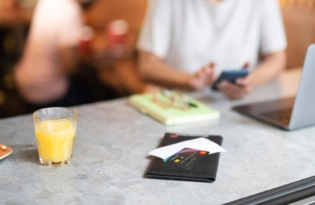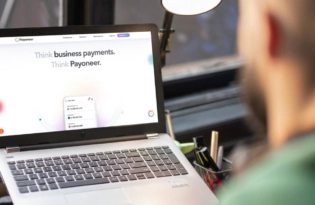Bank routing number: What is it and how to find yours
Do you send money internationally? Bank routing numbers are an important part of global banking. Learn what they are, how to find yours, when to use it, and more in this guide to bank routing numbers.

What is a bank routing number?
Also known as the American Bankers Association (ABA) routing number, a bank routing number is a unique nine-digit code assigned to financial institutions in the U.S. It identifies the financial institution – like a bank or credit union – where a bank account is held during a transaction.
Routing numbers are issued to federal or state-chartered financial institutions that are eligible to maintain an account at a Federal Reserve Bank. They show banking systems that the account is legitimate.
The routing number also ensures that you are transferring funds to the correct institution and account. It is essential for different transactions, including direct deposits, wire transfers, electronic payments, and automatic bill payments.
You will need the Payoneer routing number for your American account to get paid through Payoneer.
The anatomy of a bank routing number
Routing numbers are prevalent in the U.S., but what do the different digits mean? Here is a breakdown:
Digits 1-4: Identification code
The first four numbers of a routing number are the identification code. They identify the Federal Reserve Bank responsible for the institution.
These digits indicate the bank’s geographic location as follows:
- The first two digits represent the Federal Reserve Bank’s district
- The second two represent the Federal Reserve Bank’s processing center
Digit 5: Check digit
The fifth digit of a routing number is the check digit, which verifies the authenticity of the routing number. It is calculated based on a formula that uses the first eight digits of the routing number.
The check digit prevents errors when processing checks and electronic transactions.
Digits 6-9: Identifying the institution
The last four digits identify the specific financial institution. These digits are unique to each institution. They indicate the bank’s location, type of institution, and the individual account associated with the routing number.
When you’ll need your routing number
You’ll need to provide a routing number to complete a transaction in many instances. Here are a few examples:
- Setting up your direct deposit payments from clients
- Receiving incoming wire transfers or payments from international clients or partners
- Initiating funds transfers between accounts with different banks or financial institutions – like transferring funds from your Bank of America or CIT bank account to your Payoneer account
- Making electronic bank statement requests (you’ll provide your routing number to your bank or financial institution)
- Setting up automatic online bill payments (you’ll provide your routing number to the biller)
- Processing digital checks
- Linking your Payoneer account to a budgeting app (you’ll provide your routing number to connect to your account)
- Processing checks
- Completing bank transactions virtually ortelephonically
- Reordering checks
Types of bank routing numbers
The most common types of bank routing numbers are:
ABA/routing transit numbers (RTN)
The American Bankers Association assigns routing transit numbers (RTNs) to identify a financial institution. The nine-digit numbers are vital for many transactions, including direct deposits, wire transfers, and bill payments.
They are also known as American Banking Association or ABA routing numbers.
Non-ABA/institution numbers (IBANs)
Financial institutions outside the United States use International Bank Account Numbers (IBANs). IBANs consist of up to 34 alphanumeric characters that identify the bank and specific account associated with a transaction.
Electronic transfer account (ETA) codes
The Electronic Transfer Account (ETA) program is a low-cost bank account offered by the U.S. government. It’s for bank customers or individuals who receive federal benefit payments, such as Social Security and Supplemental Security Income (SSI).
ETA accounts use a unique ETA code, different from a traditional routing number, to process electronic payments.
Where to find your bank routing number
To conduct financial transactions successfully, you’ll need to enter the routing number correctly. Now that you know how routing numbers influence your financial transactions, here is how you can find them:
On your checkbook or deposit slip
The most common place to find your bank’s routing number is your checkbook or deposit slip. Look at the lower-left corner of your paper check and locate the first nine-digit number.
Online banking profile
You can find your bank’s routing number by logging into your account and opening the account summary section. This method is convenient and saves you time. It’s much better than searching for the routing number on a physical check or deposit slip!
Additionally, you can easily copy the number when you need to enter or paste it digitally to complete a transaction.
Mobile app
You can also find your routing number through your mobile banking app. Go to the account information section of the app. You’ll see your routing number and other account details.
How to find your Payoneer routing number
As mentioned above, Payoneer also uses routing numbers to complete financial transactions through American institutions. The routing number is similar to that of banks, composed of three parts.
- The first four digits represent the location of the Federal Reserve Bank, which serves as Payoneer’s primary processing center
- The fifth digit uses a specific algorithm to ensure the accuracy of the routing number
- The final four digits are specific to Payoneer as the financial institution associated with the routing number
To find your Payoneer routing number, log in to your account and go to the “Receive” tab. Your routing number and virtual account details are in the “Global Payment Service” section.
Ways to use bank routing numbers
You want a reliable and efficient way to transfer funds between your accounts and pay your vendors or employees. Bank routing numbers provide the solution you need, making it easy to conduct wire transfers, direct deposits, and transfers between accounts.
Below are three methods Payoneer uses for transferring funds conveniently.
Wire transfers
Wire transfers are a secure and fast way to transfer funds from one bank account to another. They involve the transferring of money electronically through a network of banks. Wire transfers are also the best way to receive international payments from B2B businesses and partners.
You can use your bank routing number to wire money from your Payoneer account to another account – within the same country or across borders.
Direct deposits
Direct deposits are a convenient way to receive payments directly into your bank account. You only need to provide your routing number to the payer, and they’ll transfer funds directly into your account.
Transfers between accounts
You can use your bank routing number to transfer funds between your accounts. It’s a convenient way to handle your finances, especially if you have multiple accounts with different financial institutions. You can also withdraw funds from your Payoneer account into your bank account when you have a routing number.
Bank routing numbers: A key part in making everyday transactions
Electronic and online transactions are increasing daily, meaning smooth and efficient processing is more critical than ever. Knowing your bank routing number can ensure quick and accurate transactions that save you time and money.
With the information above, you can increase the efficiency of your transactions using Payoneer’s stellar financial services – whether it’s setting up a direct deposit, sending and receiving wire transfers, or making payments from your bank account.
Related resources
Latest articles
-
How to hire employees in Ireland
Looking to hire employees in Ireland for your US company? Learn about employment in Ireland and how Payoneer Workforce Management makes it easy to hire in Ireland.
-
Planning to hire employees in Indonesia? Here’s a quick guide
Are you looking to hire employees in Indonesia? Learn about hiring in Indonesia and how Payoneer Workforce Management can help American companies hiring in Indonesia.
-
Planning to hire employees in France? Here’s a quick guide
Looking to hire employees in France for your U.S. company? Learn about employment in France and how Payoneer Workforce Management makes it simple to hire in France.
-
Planning to hire employees in Spain? Here’s a quick guide
Are you looking to hire employees in Spain? Learn about employment in Spain and how Payoneer Workforce Management can help American companies hiring in Spain.
-
How to hire employees in the Netherlands
Looking to hire employees in the Netherlands for your U.S. company? Learn about employment in the Netherlands and how Payoneer Workforce Management can help hire in the Netherlands.
-
How to hire employees in Australia
Looking to hire employees in Australia for your US company? Learn about employment in Australia and how Payoneer Workforce Management makes it easy to hire in Australia.
Disclaimer
The information in this article/on this page is intended for marketing and informational purposes only and does not constitute legal, financial, tax, or professional advice in any context. Payoneer and Payoneer Workforce Management are not liable for the accuracy, completeness or reliability of the information provided herein. Any opinions expressed are those of the individual author and may not reflect the views of Payoneer or Payoneer Workforce Management. All representations and warranties regarding the information presented are disclaimed. The information in this article/on this page reflects the details available at the time of publication. For the most up-to-date information, please consult a Payoneer and/or Payoneer Workforce Management representative or account executive.
Availability of cards and other products is subject to customer’s eligibility. Not all products are available in all jurisdictions in the same manner. Nothing herein should be understood as solicitation outside the jurisdiction where Payoneer Inc. or its affiliates is licensed to engage in payment services, unless permitted by applicable laws. Depending on or your eligibility, you may be offered the Corporate Purchasing Mastercard, issued by First Century Bank, N.A., under a license by Mastercard® and provided to you by Payoneer Inc., or the Payoneer Business Premium Debit Mastercard®, issued and provided from Ireland by Payoneer Europe Limited under a license by Mastercard®.
Skuad Pte Limited (a Payoneer group company) and its affiliates & subsidiaries provide EoR, AoR, and contractor management services.












